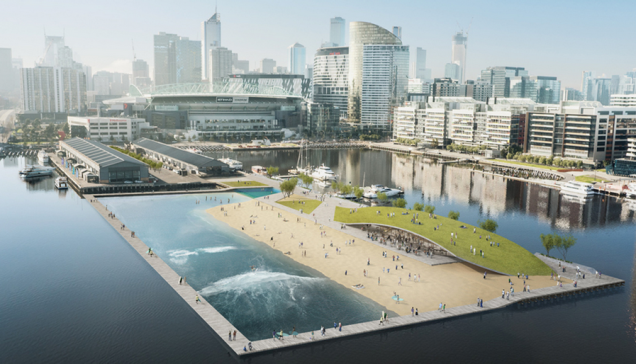Australia has many great surfing coasts, but for some in Melbourne it would be even better to have the option to catch some waves just steps from the city.
Enter the Docklands Surf Park, a project proposal by Arup and Damian Rogers Architecture that involves creating a massive wave pool of sorts near the city's Docklands neighborhood. The surfing pool would offer 98-foot-wide waves that would run the length of the 500-foot-long enclave, reports Australian newspaper The Age.
The project is in the very early stages of its proposal and still far from realization, but that hasn’t stopped the plan from garnering a lot of fanfare and support from Melburnians and surf enthusiasts.
As for the project’s reception from city officials, this is what surfing magazine Stab reports:
“Arup [is] seeking funding from developers and potential operators rather than the government, but Melbourne City Council and Places Victoria would still have to approve construction. Both [organizations] have met with Arup, and a council spokeswoman said it was an 'interesting concept' if private funding were available. The city of Melbourne has yet to officially back the project.”
More on the story at Gizmodo and The Age.
Related Stories
| Oct 11, 2011
ThyssenKrupp elevator cabs validated by UL Environment
The conclusive and independent third-party validation process is another step toward a green product line.
| Oct 11, 2011
Ballard Spahr launches real estate recovery group
The new group represents an expansion of the company’s Distressed Real Estate Initiative, which was launched in 2008 to help clients throughout the country plan, adapt and prosper in a challenging economic environment.
| Oct 11, 2011
Onex completes investment in JELD-WEN
With the completion of the JELD-WEN investment, Onex Partners III is approximately 40% invested.
| Oct 7, 2011
GREENBUILD 2011: Demand response partnership program announced at Greenbuild 2011
Program will use USGBC’s newly revised LEED Demand Response credit as an implementation guideline and leverage its relationships with the building community to foster adoption and participation in existing utility and solution provider demand response offerings.
| Oct 7, 2011
GREENBUILD 2011: Otis Elevator announces new contracts for sustainable building projects
Wins reinforce Otis’ position as leader in energy-efficient products.
| Oct 7, 2011
GREENBUILD 2011: UL Environment releases industry-wide sustainability requirements for doors
ASSA ABLOY Trio-E door is the first to be certified to these sustainability requirements.
| Oct 7, 2011
GREENBUILD 2011: UL Environment clarifies emerging environmental product declaration field
White paper defines EPD, details development process, and identifies emerging trends for manufacturers, architects, designers, and buyers.
| Oct 7, 2011
GREENBUILD 2011: Otis Elevator introduces energy-efficient escalator
The energy-efficient NCE escalator from Otis offers customers substantial “green” benefits.
| Oct 7, 2011
GREENBUILD 2011: Schools program receives grant to track student conservation results
To track results, schools will use the newly developed Sustainability Dashboard, a unique web-based service that makes tracking sustainability initiatives affordable and easy.
| Oct 7, 2011
GREENBUILD 2011: Transparent concrete makes its North American debut at Greenbuild
The panels allow interior lights to filter through, from inside.


















